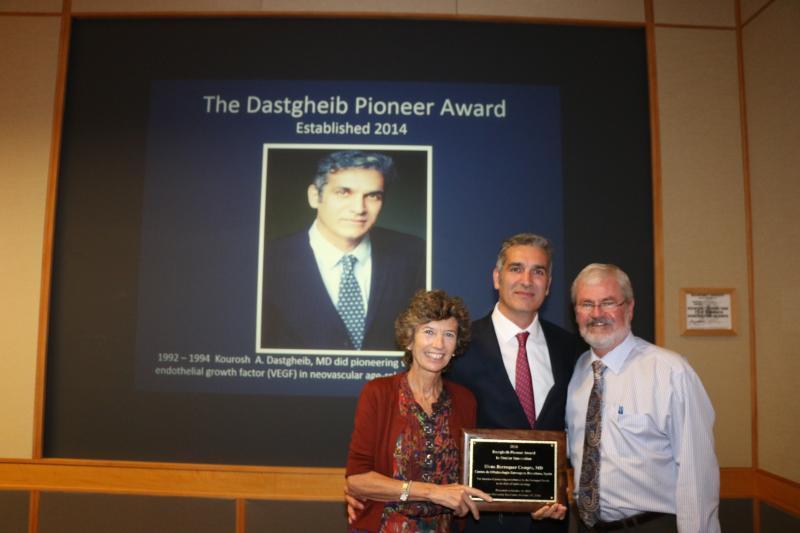
Elena Barraquer Compte, MD presented The Social Entrepreneurship: From “El Dispensario to Fundacion Barraquer” as the Dastgheib Pioneer Award lecturer in Ocular Innovation. Dr. Barraquer shared the history and dedication to ophthalmology of the Centro De Oftalmologia Barraquer, Barcelona, Spain and shared her humanitarian eye care expeditions of Fundació Barraquer.
Established by Duke Eye Center Alumni, Kourosh Alexander Dastgheib, the Dastgheib Pioneer Award in Ocular Innovation Lecturer is awarded annually to someone who has made a major contribution in the field of Ophthalmology focused on something that has proved useful in real life.
Dr. Elena Barraquer Compte was born in Barcelona, Spain. She is the oldest daughter of Professor Joaquín Barraquer, and with her younger brother belong to the fourth generation of the Barraquer ophthalmologist’s saga.
She graduated in Medicine and Surgery from the Universitat Autònoma de Barcelona in 1977. When she completed her practical training at the Hospital Universitari Vall d’Hebron, she was granted a Research Scholarship at the National Eye Institute of the National Institutes of Health of Bethesda, Maryland, USA. While in the USA, she expanded her curriculum as a fellow in Ocular Pathology at the Wilmer Eye Institute. Following her fellowship at Wilmer, she passed the Educational Commission for Foreign Medical Graduates ECFMG examination which allowed her to continue her medical training in the USA. Dr. Barraquer Compte completed her Cornea fellowship at Bascom Palmer Eye Institute and become Chief Ophthalmologist-Surgeon at the Studio Medico Associato Barraquer Bosio in Turin (Italy), where she enhanced her practical knowledge and achieved a high professional prestige.
Since arriving in Barcelona in 2002, she has been Assistant Medical Director of the Centro de Oftalmología Barraquer and has coordinated patient care and management of the center along with her brother, Dr. Rafael I. Barraquer, and under the supervision of Professor Joaquín Barraquer.
Her clinical practice includes the Anterior Segment of the eye, specialising in clinical ophthalmology of cornea, lens and ocular surface. It is outstanding her work as cataract surgeon. She was one of the pioneering doctors in Spain to use posterior chamber intraocular lenses and to perform extracapsular cataract extraction. This technique substituted intracapsular surgery, which had been predominant until the 80’s, and had been developed by her grandfather, Professor Ignacio Barraquer and later on improved by her father, Professor Joaquín Barraquer.
In 2004 she promoted the first humanitarian eye care expedition of the Fundació Barraquer. Together with Fundació SOS Dia Universal de la Infància she leaded a mission to Senegal (Africa) to assist hundreds of children of an orphanage in Cassamance, establishing the basis for further expeditions which would include surgical care. Since then, she has been travelling to Africa (Senegal, Cameroun, Marocco) several times a year, increasing the number of people who have recover vision after cataract surgery.
History of the Centro De Oftalmologia Barraquer, Barcelona, Spain
The Barraquer family dedication to Ophthalmology spans already four generations. This presentation will briefly review some of the contributions of the first three, and describe the main interests of this member of the fourth. The saga begins with José Antonio Barraquer R., who worked at the turn of the XIX-XX centuries and became the first University Professor of Ophthalmology in Barcelona, Spain. His son Ignacio Barraquer B. developed in 1917 a new method of cataract extraction with a vacuum spoon of his invention (the erisophake) and immediately became a celebrity in the ophthalmological world. He had two sons who followed his path. José Ignacio, the eldest, established a new Barraquer Clinic in Bogotá, Colombia, and is renowned as the father of corneal lamellar refractive surgery for his techniques of keratomileusis and keratophakia. The younger, Joaquín, stayed in Barcelona and became famous for his discovery in 1958 of enzymatic zonulolysis, a method that greatly facilitated intracapsular cataract extraction, especially in younger patients by digesting the zonular ligament intraoperatively with the use of alpha-chymotrypsin. He was also a pioneer in intraocular lenses and in keratoplasty, and founded in 1962 the first Eye Bank of continental Europe. Under his tenure, the Barraquer Clinic of Barcelona became a world reference institution in Ophthalmology, particularly for the treatment of complex cornea cases.
My dedication in our specialty could not escape the influence of these illustrious antecessors. I have been practicing mostly anterior segment, cornea and refractive surgery. I will concentrate in describing one of my research areas which I believe can be of interest for this audience. Keratoconus is one of the world’s major cornel degenerative diseases, and until recently one of the most frequent causes for a corneal transplant. While this is changing due to the emergence of novel conservative treatment modalities, their application is still somewhat limited. In the case of the intracorneal ring segments, this may be due to a lack of understanding of their mechanism of action and thus of a rationale on their application. In the last minutes of this presentation I will try to show how we approach this rather complex issue, and how it can be deconstructed in order to obtain better and more consistent results.